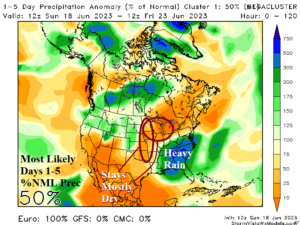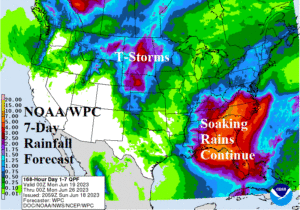Wet Trade Winds to Develop Across Record Warm SSTA (for June)
06/13/2023, 8:44 am EDTTwo Tropical Cyclones Ahead In Central North Atlantic Tropics
06/19/2023, 3:58 pm EDT


Fig. 1-3: The mega-cluster ensemble 15-day percent of normal rainfall forecast for North America.
Discussion: Discussions and photos of AG Belt soil moisture conditions, especially in Illinois, worse than conveyed by data. Rainfall deficits are in the 3-6/6-9 in. range across the Ohio Valley. A new analysis produced by NOAA is issued tomorrow and increasing rainfall deficits expected. Although not as widespread as the 2012 drought, the 2023 drought intensity is becoming similar across much of the Corn Belt. GFS and ECM vary on 15-day forecasts mostly due to new involvement of tropical weather and how to handle that development. ECM is favored for now and mega-cluster ensemble agrees. The “most likely” rainfall scenarios over the next 15 days produce a lot of rain across the Southeast and East U.S. the North-central States (Fig. 1-3). However, in-between the wet areas, most of the Corn Belt stays drier than normal as rainfall is limited. The rapidly increasing soil moisture deficits imply heavy rainfall is required. Additionally, a micro-climate may be developing. The soil moisture trend in the Midwest remains super dry during June while the Southeast States are rapidly turning wetter (Fig. 4). The NOAA/WPC 7-day rainfall forecast continues to soak the Southwest States (Fig. 5). During the summer season, high pressure and anomalous heat will be attracted to the dry soil region in the Midwest while wetter soils in the Southeast attract low pressure and added rain threat suppressing heat risk. This scenario leaves the Texas area drier which sustains the torrid heat in that zone likely to expand westward.

Fig. 4: NOAA soil moisture change across the U.S. during June so far.

Fig. 5: Latest NOAA/WPC 7-day rainfall forecast indicates the Southeast U.S. continues to receive soaking rains.
